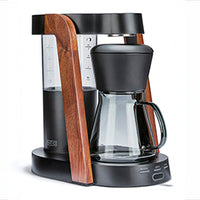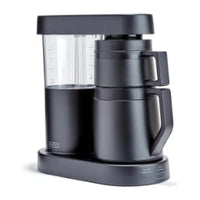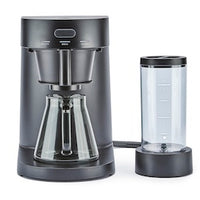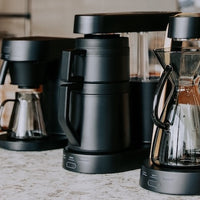When Pre-Infusion Stops Helping and Starts Hurting
Key Takeaways
-
Pre-infusion wets coffee grounds before full brewing to promote even extraction
-
Too short a pre-infusion can cause uneven flow and channeling
-
Overly long pre-infusion can lead to bitterness and flat flavors
-
Grind size, roast level, and coffee freshness all affect optimal pre-infusion time
-
Precision brewing tools, like a Ratio Coffee machine, can help dial in consistency
Pre-infusion is one of those brewing terms that sounds highly technical — and it is — but it’s also a simple concept: wetting your coffee grounds with a small amount of water before the main brew begins. The goal is to allow gases to escape and prepare the grounds for even extraction.
Done right, pre-infusion can elevate your cup, bringing out clarity and balance. Done wrong, it can rob your coffee of vibrancy and make even premium beans taste dull or overly bitter.
Let’s break down when pre-infusion crosses the line from helpful to harmful.
What Pre-Infusion Actually Does
Coffee beans release carbon dioxide after roasting. When hot water first contacts the grounds, CO₂ rapidly escapes — a process called the “bloom.” If brewing begins before the gas escapes, water can channel unevenly through the coffee bed, leaving some grounds under-extracted and others over-extracted.
Pre-infusion lets you control that bloom, saturating the grounds evenly and minimizing extraction problems.
But here’s the catch: while some gases are good to release, prolonged contact with water before brewing can also start extracting soluble compounds prematurely. That means you could be pulling bitterness into the cup before you even begin brewing in earnest.
When Short Pre-Infusion Fails
If your pre-infusion is too short — say, just a second or two — CO₂ might not escape fully. The water in the main brew cycle will then meet pockets of trapped gas, pushing it away from certain grounds and causing “dry spots” in the coffee bed. The result? A brew with sharp highs, hollow mids, and an inconsistent mouthfeel.
Signs your pre-infusion might be too short:
-
You see bubbles throughout brewing, especially in the early stages
-
The final cup has uneven flavor from sip to sip
-
You notice streaks of dry grounds along the filter walls
When Long Pre-Infusion Over-Extracts
On the other side of the spectrum, pre-infusion that’s too long can flatten a coffee’s character. As the grounds sit wet, soluble bitter compounds start dissolving early, even before balanced flavors have a chance to develop.
Signs your pre-infusion might be too long:
-
The first sip is noticeably bitter or harsh
-
The coffee lacks brightness or complexity
-
Dark roasts taste heavy and ashy instead of rich
For most brew methods, 20–45 seconds of pre-infusion is a safe starting point, but factors like roast level and grind size can push that number up or down.
The Grind Size Connection
Grind size changes how pre-infusion behaves:
-
Finer grinds absorb water faster and release CO₂ more quickly — they need shorter pre-infusion times.
-
Coarser grinds take longer to saturate, so they often benefit from a slightly longer bloom phase.
If you change grind size but don’t adjust pre-infusion, you risk upsetting your flavor balance.
Roast Level and Freshness Matter
Freshly roasted coffee (within 2–3 weeks of roasting) produces more CO₂, requiring a slightly longer pre-infusion. Lighter roasts tend to be denser and less porous, so they need more time to saturate. Dark roasts, being more porous, require less time.
Brew Method-Specific Pre-Infusion Ranges
-
Pour-over (V60, Chemex): 30–45 seconds for most beans
-
French press: Not typically necessary, but a short 15–20 second bloom can help
-
Espresso: 2–8 seconds depending on machine pressure and roast level
-
Automatic coffee machine with bloom function: Often preset between 20–40 seconds
How to Tell You’ve Found the Sweet Spot
The goal is even saturation without bitterness creeping in early. You know you’ve hit the mark when:
-
The bloom rises evenly and settles without leaving dry patches
-
The brew draws down at a steady rate without sudden spurts
-
The cup tastes balanced, with clarity in the flavor notes
If you tweak pre-infusion and your coffee suddenly tastes brighter, sweeter, or more complex, you’ve likely been over- or under-doing it before.
Why Consistency Matters
Changing beans, grind settings, or brew devices means you’ll need to adjust pre-infusion each time. Keeping notes — even if it’s just a few seconds’ difference — helps you avoid starting from scratch every brew.
Bringing It All Together
Pre-infusion is a powerful tool, but it’s not a “more is better” scenario. The key is finding the time that works with your grind size, roast level, and brewing method. Even a small adjustment — shaving five seconds off or adding a few more — can turn a good cup into a great one.
Precision coffee machines, like those from Ratio Coffee, are designed to keep pre-infusion consistent, making it easier to experiment and lock in your ideal flavor profile.
Frequently Asked Questions
What is pre-infusion in coffee brewing?
It’s the process of wetting the coffee grounds briefly before the main brew to release gases and prepare for even extraction.
Can I skip pre-infusion?
For very fresh beans, skipping it can lead to uneven extraction. For older beans, it’s less critical but still helpful.
Does pre-infusion time affect strength?
Not directly, but it affects extraction balance, which changes how strong or weak a cup feels in flavor.
Should espresso have pre-infusion?
Yes, though the timing is shorter than for filter coffee. It helps reduce channeling and improve consistency.
How do I test pre-infusion times?
Brew the same coffee with different pre-infusion durations, keeping all other variables the same, and taste the difference.
 Ratio Eight S2
Ratio Eight S2
 Ratio Eight Original
Ratio Eight Original
 Ratio Six
Ratio Six
 Ratio Four
Ratio Four
 Compare Machines
Compare Machines






